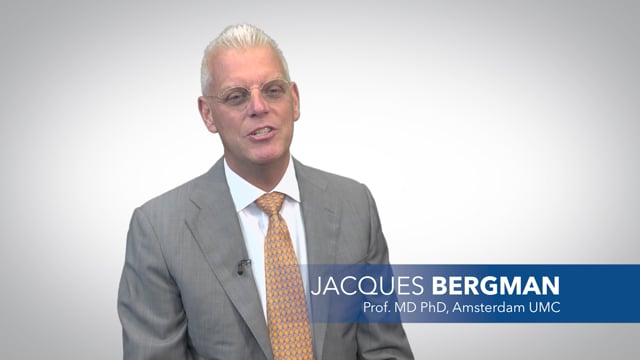Clinical Summary
New Data from DDW 2022
An Objective, Fully Automated Barrett’s Risk Prediction Assay Outperforms Pathology in Risk Stratifying Barrett’s Esophagus with Low-Grade Dysplasia
A.M. Khoshiwal, N.F. Frei, L.C. Duits, R.E. Pouw, Barrett’s SURF LGD Study Pathologist Consortium, E. Bossart, M. Wilhelm, R. Critchley-Thorne, J.J. Bergman
Abstract
Risk stratification of patients in Barrett’s Esophagus (BE) surveillance is largely based on histologic review of biopsies by pathologists. While diagnosis of low-grade dysplasia (LGD) is one of the strongest predictors of progression to high grade dysplasia (HGD) or esophageal adenocarcinoma (EAC), distinguishing reactive inflammation (“atypia”) from dysplasia is not easy. Confirmed LGD carries a 1.7 to 10% annual risk for progression to HGD/EAC2, and guidelines call for endoscopic eradication therapy or annual surveillance making it is critical to accurately identify which patients are more likely to progress. When LGD is diagnosed by a general pathologist, it reflects an overdiagnosis as often as 73 to 85% of the time3,4. This overestimation of the patient’s risk for progression to cancer could result in unnecessary clinical procedures and concern by the patient. To minimize misdiagnosis, guidelines recommend that LGD diagnoses are confirmed by an expert GI pathologist.
The study performed by Dr. Jacques Bergman’s group at Amsterdam University Medical Centers in collaboration with Castle Biosciences reiterated that conventional pathology review based on histology, even by the world’s leading GI pathologists, has limitations, and that the TissueCypher BE risk assessment tool can improve the accuracy of prognosis. TissueCypher is an objective, readily accessible, and highly reproducible test that has been shown by multi-variate analysis to be the most significant independent predictor or progression to HGD or EAC5. This makes TissueCypher an important risk stratification tool for BE patients diagnosed with LGD, and a viable alternative to expert pathology for risk stratification of community-diagnosed low-grade dysplasia.
Aims
Risk stratification of patients diagnosed with low-grade dysplasia needs to be improved. Expert GI pathology is the current standard of care but is not well defined or easily accessible. The aim of this study was to assess the performance of TissueCypher compared to a panel of community-based general pathologists and expert GI pathologists from five countries to determine how TissueCypher could be used to risk stratify LGD.
Methods
One hundred and fifty-four patients with a diagnosis of LGD from community-based pathologists were selected from the screening cohort of the SURF trial. The tissue samples were assessed using TissueCypher and a panel of 16 community-based generalists and 14 expert GI pathologists. In this cohort there were 24 patients who progressed to high-grade dysplasia or esophageal adenocarcinoma within 5 years.
Research Highlights with Jacques Bergman
Interview Topics
- How common is Barrett’s esophagus and why is it so important to physicians?
- What tools do physicians use to stratify the risk of Barrett’s esophagus progressing to cancer?
- How do you determine who should be treated prophylactically?
- What is the definition of an expert pathologist?
- What is the risk of skipping the secondary confirmation of low grade dysplasia by an expert pathologist?
- Why did you decide to compare the performances of TissueCypher and expert pathology?
- What were the key findings of your study?
- What is the role for TissueCypher in confirming low grade dysplasia?
- Can this thinking be extended to pathology that returns indefinite for dysplasia?
- How does TissueCypher perform in biopsies determined to be non-dysplastic by pathology?


Results
The results show extreme variability among both community-based and expert GI pathologists with sensitivity ranging from 33% to 88%. At the extremes the pathologists tended to under and over diagnose patients which would potentially negatively impact the patient’s care plan. Fleiss’ Kappa scores confirm weak agreement6 (0.34) for general pathology and moderate agreement6 (0.43) for expert GI pathologists respectively.
TissueCypher’ higher sensitivity increases the early detection of progressors, and better risk-stratifies patients with positives progressing at a higher rate and negatives progressing at a lower rate than pathologic diagnosis.
Figure 1: Comparison of key performance metrics of TissueCypher vs. the mean performance of 30 expert and general pathologists for predicting progression to HGD or EAC in patients initially diagnosed as community practice LGD.
References
- Khoshiwal et al. Presented at DDW 2022.
- Singh et al. Gastrointest Endosc. 2014 Jun;79(6):897-909.e4; quiz 983.e1, 983.e3
- Curvers et al. Am J Gastroenterol. 2010 Jul;105(7):1523;
- Duits et al. Gut. 2015 May;64(5):700-6.;
- Iyer et al. Clin Gastroenterol Hepatol 2022
- McHugh. Biochem Med (Zagreb) 2012
Have questions about integrating TissueCypher® into your practice?
Contact us to discuss the science behind our technology and how TissueCypher® can be integrated into your practice.


